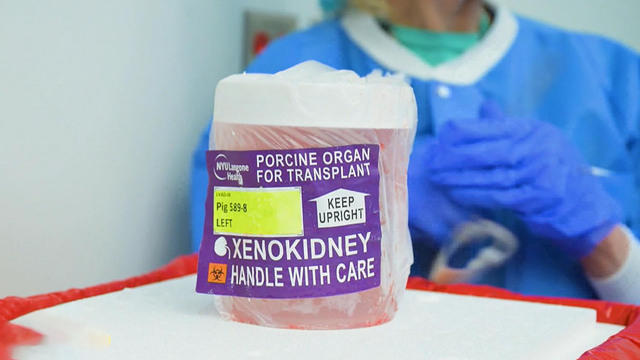▶ Watch Video: Pig kidney transplant gives woman a second chance at life
For the first time, surgeons at NYU Langone Health performed a combined mechanical heart pump and gene-edited pig kidney transplant, helping a 54-year-old woman with heart and kidney failure.
Before the two procedures, which took place earlier this month, New Jersey native Lisa Pisano faced heart failure and end-stage kidney disease that required routine dialysis, and she was not a candidate for a human transplant.
“I was pretty much done,” Pisano told CBS News chief medical correspondent Dr. Jon LaPook, who is also a professor at NYU Langone. “I couldn’t go up the stairs. I couldn’t drive. I couldn’t play with my grandkids. So when this opportunity came to me I was taking it.”
Now, she says, she’s feeling “great today compared to other days.”
Dr. Robert Montgomery, NYU Langone Transplant Institute director, said she is currently “doing very well” in recovery.
Pisano received only the second known transplant of a gene-edited pig kidney into a living person, and the first to include the pig’s thymus gland to aid against rejection, the hospital said. The transplant surgery took place on April 12, eight days after the heart pump, called a left ventricular assist device, or LVAD, was implanted on April 4.
Last month, surgeons at Massachusetts General Hospital in Boston transplanted a pig kidney into 62-year-old Rick Slayman, marking the first successful procedure of its kind in a living human patient in the world.
Rejection issues with animal-to-human transplants, or xenotransplantation, have led to failures, largely due to people’s immune systems attacking the foreign tissue. Now, scientists are using genetic modification to better match those organs to humans.
“The human immune system rejects organs from animals, but Dr. Montgomery and his team used a pig kidney with one gene altered to make it more compatible,” LaPook explains.
Montgomery says this is about more than just the organ itself.
“This isn’t just about keeping somebody alive, it’s restoring them to their their lives,” he says.
For Pisano, it means dreams of playing with her two young grandchildren for the first time in years, she says.
LaPook adds this procedure was done under the FDA’s “compassionate use” protocol. “So it’s not approved yet — but what an amazing technological tour de force,” he said.



































